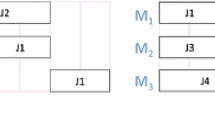Abstract
The partially-concurrent open shop scheduling problem is introduced. The standard open shop scheduling problem is generalized by allowing some operations to be processed concurrently. A schedule for the partially-concurrent problem is represented by a digraph. We show that the scheduling problem is equivalent to a problem of orienting a given undirected graph, called a conflict graph. The schedule digraph is then modeled by a matrix, generalizing the rank matrix representation. The problem is shown to be NP-hard. The representation can be used to generalize previously discussed standard open shop issues. It is demonstrated by generalizing the theoretical concept of reducibility and also by using standard open shop heuristic solutions to the partially-concurrent scenario. The presented problem is directly motivated from a real-life timetabling project of assigning technicians to airplanes in an airplane garage.







Similar content being viewed by others
Notes
The results for 0 % concurrency are worse than those presented by Bräsel et al. (1993), since the machine lower bound used herein is looser than the (machine and job) lower bound used by Bräsel et al.
The lower bound of a standard OSS is the maximal sum of processing times in a given machine or job. In a unit OSS with \(m>n\) it equals m. For a unit PCOSS the lower bound is \(\max (n, \{\tilde{m_j}\})\), where \(\tilde{m_j}\) is the maximum independent set of the jth job. The problem of finding a maximum independent set is known to be NP-hard.
References
Andresen, M., & Dhamala, T. N. (2012). New algorithms and complexity status of the reducibility problem of sequences in open shop scheduling minimizing the makespan. Annals of Operations Research, 196(1), 1–26.
Andresen, M., Bräsel, H., Mörig, M., Tusch, J., Werner, F., & Willenius, P. (2008). Simulated annealing and genetic algorithms for minimizing mean flow time in an open shop. Mathematical and Computer Modelling, 48(7), 1279–1293.
Bang-Jensen, J., & Gutin, G. Z. (2008). Digraphs: Theory, algorithms and applications. Berlin: Springer.
Barbosa, V. C., & Szwarcfiter, J. L. (1999). Generating all the acyclic orientations of an undirected graph. Information Processing Letters, 72(1), 71–74.
Bräsel, H. (2006). Matrices in shop scheduling problems. In M. Morlock, C. Schwindt, N. Trautmann & J. Zimmermann (Eds.), Perspectives on operations research (pp. 17–41). Berlin: Springer.
Bräsel, H., & Kleinau, M. (1992). On the number of feasible schedules of the open-shop-problem—an application of special latin rectangles. Optimization, 23(3), 251–260.
Bräsel, H., & Kleinau, M. (1996). New steps in the amazing world of sequences and schedules. Mathematical Methods of Operations Research, 43(2), 195–214.
Bräsel, H., Tautenhahn, T., & Werner, F. (1993). Constructive heuristic algorithms for the open shop problem. Computing, 51(2), 95–110.
Bräsel, H., Kluge, D., & Werner, F. (1995). A polynomial algorithm for an open shop problem with unit processing times and tree constraints. Discrete Applied Mathematics, 59(1), 11–21.
Bräsel, H., Harborth, M., Tautenhahn, T., & Willenius, P. (1999). On the set of solutions of the open shop problem. Annals of Operations Research, 92, 241–263.
Bräsel, H., Harborth, M., & Willenius, P. (2001). Isomorphism for digraphs and sequences of shop scheduling problems. Journal of Combinatorial Mathematics and Combinatorial Computing, 37, 115–128.
Castillo-Salazar, J. A., Landa-Silva, D., & Qu, R. (2012). A survey on workforce scheduling and routing problems. In Proceedings of the 9th international conference on the practice and theory of automated timetabling (pp. 283–302).
Graham, R. L., Lawler, E. L., Lenstra, J. K., & Rinnooy Kan, A. (1977). Optimization and approximation in deterministic sequencing and scheduling: A survey. Annals of Discrete Mathematics, 5, 287–326.
Kolisch, R., & Drexl, A. (1997). Local search for nonpreemptive multi-mode resource-constrained project scheduling. IIE Transactions, 29(11), 987–999.
Leung, J. Y. T., Li, H., & Pinedo, M. (2005). Order scheduling in an environment with dedicated resources in parallel. Journal of Scheduling, 8(5), 355–386.
Mastrolilli, M., Queyranne, M., Schulz, A. S., Svensson, O., & Uhan, N. A. (2010). Minimizing the sum of weighted completion times in a concurrent open shop. Operations Research Letters, 38(5), 390–395.
Naderi, B., Fatemi Ghomi, S., Aminnayeri, M., & Zandieh, M. (2010). A contribution and new heuristics for open shop scheduling. Computers & Operations Research, 37(1), 213–221.
Ng, C. T., Cheng, T. C. E., & Yuan, J. J. (2003). Concurrent open shop scheduling to minimize the weighted number of tardy jobs. Journal of Scheduling, 6(4), 405–412.
Pinedo, M. (2012). Scheduling: Theory, algorithms, and systems. Berlin: Springer.
Roemer, T. A. (2006). A note on the complexity of the concurrent open shop problem. Journal of Scheduling, 9(4), 389–396.
Smith-Miles, K., & Lopes, L. (2012). Measuring instance difficulty for combinatorial optimization problems. Computers & Operations Research, 39(5), 875–889.
Taillard, E. (1993). Benchmarks for basic scheduling problems. European Journal of Operational Research, 64(2), 278–285.
Wagneur, E., & Sriskandarajah, C. (1993). Openshops with jobs overlap. European Journal of Operational Research, 71(3), 366–378.
Author information
Authors and Affiliations
Corresponding author
Rights and permissions
About this article
Cite this article
Grinshpoun, T., Ilani, H. & Shufan, E. The representation of partially-concurrent open shop problems. Ann Oper Res 252, 455–469 (2017). https://doi.org/10.1007/s10479-015-1934-1
Published:
Issue Date:
DOI: https://doi.org/10.1007/s10479-015-1934-1




